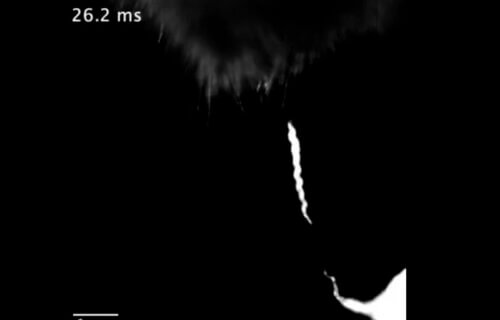HIROSHIMA, Japan — Nature can provide some incredible moments, and a new video reveals that even tiny worms may have superpowers. Scientists in Japan were able to capture the moment a tiny worm species, known as Caenorhabditis elegans, used electricity to propel itself through the air and leap onto a bumblebee.
Scientists have long observed that smaller creatures frequently attach themselves to larger ones in nature to conserve energy over large distances. However, this new study reveals a unique method employed by the microscopic C. elegans worms. The worms use electric fields to “jump” across Petri dishes or onto insects, gliding through the air and attaching themselves to entities like electrically charged bumblebees.
“Pollinators, such as insects and hummingbirds, are known to be electrically charged, and it is believed that pollen is attracted by the electric field formed by the pollinator and the plant,” says Takuma Sugi, a biophysics professor at Hiroshima University and co-senior author on the study. “However, it was not completely clear whether electric fields are utilized for interactions between different terrestrial animals.”
The Japanese research team initially began their investigation when they noticed that the worms they cultivated frequently ended up on the lids of their Petri dishes, far from the agar they initially placed them on. After attaching a camera to monitor the worms’ behavior, they discovered that the worms were not simply climbing the dish walls, but rather leaping from the dish floor to the ceiling.
The researchers, suspecting they were traveling using electric fields, placed the worms on a glass electrode. They found that the worms only made the leap to another electrode once a charge was applied. The worms jumped at an average speed of 0.86 meters per second, which is comparable to a human’s walking speed. This speed increased with the intensity of the electric field.
To mimic a natural electric charge, the researchers dusted a bumblebee with flower pollen. When in proximity to the bees, the worms would raise their tails and leap aboard. Some worms even stacked atop one another, leaping in a single column, thereby transporting as many as 80 worms at once across the gap.
“Worms stand on their tail to reduce the surface energy between their body and the substrate, thus making it easier for themselves to attach to other passing objects,” Sugi says in a media release. “In a column, one worm lifts multiple worms, and this worm takes off to transfer across the electric field while carrying all the column worms.”
According to Prof. Sugi, it is known that C. elegans attach themselves to bugs and snails for transportation. However, as these creatures don’t carry electric fields well, direct contact is required. The worms are also known to jump onto winged insects, but it was unclear how these microscopic worms could cover such significant distances.
Sugi suggests that their research sheds light on the mystery, proposing that winged insects naturally accumulate an electrical charge during flight, thereby producing an electric field that C. elegans can travel along. The exact mechanism through which C. elegans performs this behavior is still unclear, but genetics may play a part.
Researchers observed similar jumping behaviors in worm species closely related to C. elegans. Interestingly, they noted that mutants unable to sense electric fields jumped less frequently than their normal counterparts.
Prof. Sugi highlights the need for further research to determine the specific genes involved in these jumps, and to ascertain whether other microorganisms are also capable of utilizing electricity to facilitate their jumps.
The study is published in the journal Current Biology.
You might also be interested in:
- Nightmare: Tiny mites mate on your FACE while you sleep, researchers discover
- Here’s how sunflowers could save bumblebees from extinction
- Best Insecticide: Top 5 Bug Repellents Most Recommended By Experts
South West News Service writer Stephen Beech contributed to this report.

